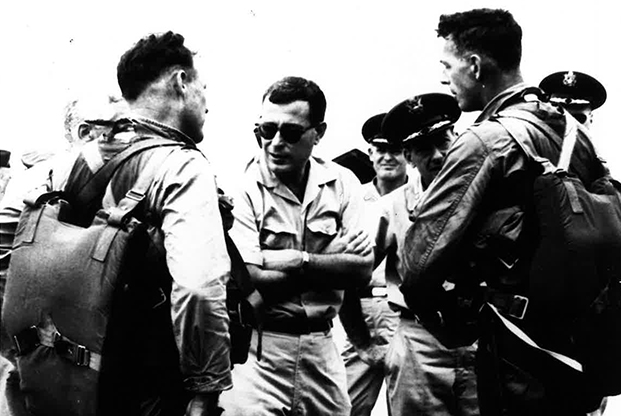
Secretary of the Air Force Harold Brown, center, is briefed by 14th Tactical Reconnaissance Squadron crew men after the completion of an aerial mission over the southern panhandle of Vietnam. Giving the report are Maj. Helmuth L. Uken, (left), and Lt. Col. Stephen R. Neiley, Jr. (right). Air Force photo.
Harold Brown, Secretary of the Air Force from 1965-1969 and Secretary of Defense during the Carter Administration, died Jan. 4 in California, at the age of 91. Brown also served as president of the California Institute of Technology and as an arms control negotiator under the Nixon Administration. He was a key figure in the development of the nation’s nuclear arsenal and policies.
Perhaps the definitive “whiz kid” of the Kennedy Administration, Brown received a doctorate in nuclear physics from Columbia at the age of 21, and went on to a distinguished career in nuclear weapons design, eventually becoming head of the Lawrence Livermore nuclear laboratories. He played an important role in the development of the Polaris nuclear missile during the 1950s.
Defense Secretary Robert McNamara brought Brown into the Pentagon at the age of 33 to serve as director of defense research and engineering. In that role he oversaw the development of Multiple, Independently-targeted Re-entry vehicles (MIRVs) and pushed for the multi-service TFX combat aircraft, which eventually served in the Air Force as the F-111.
Elevated to Secretary of the Air Force in 1965 at the age of 38, Brown oversaw the bombing of North Vietnam during the Johnson Administration. President Nixon appointed Brown to serve on the Strategic Arms Limitation Talks (SALT) I negotiating team, which led to an agreement between the US and Soviet Union to curtail the growth of their respective nuclear arsenals. The treaty was dropped by Carter after the Soviet invasion of Afghanistan.
President Carter appointed Brown Defense Secretary in 1976; the first scientist to hold that position. Though he had a mandate from Carter to reduce defense spending, Brown laid the technological groundwork for many of the “second offset” technologies that underwrote US military dominance from the 1980s-2010s, such as stealth, cruise missiles, satellite guidance, advanced propulsion, and advanced sensors. He also persuaded Carter to seek a substantially larger defense budget in the last year of that administration. He was not persuaded of the effectiveness of the B-1 bomber, however, and canceled that program in favor of equipping B-52s with Air-Launched Cruise Missiles and investing in the Advanced Technology Bomber, which became the B-2 stealth bomber. He also approved development of the M-X missile, intended to be the successor to the Minuteman, and persuaded NATO allies to accept the deployment of Pershing II and Griffin land-based theater nuclear missiles on their soil.
Under Carter, Brown also established the “countervailing” strategy for use of nuclear weapons, which went beyond the targeting of cities and industry to focus on “options to attack the targets that comprise the Soviet military force structure and political power structure and to hold back a significant reserve.” Brown believed such a strategy to be more credible than the threat of attacking only civilians.
Brown provided technical and security direction to the negotiations ultimately leading to the Camp David Accords between Israel and Egypt, and was the key figure in developing the SALT II nuclear arms agreement between Carter and Soviet leader Leonid Brezhnev. His most notable failure, however, was the “Desert One” mission, intended to rescue American hostages held in Iran. Brown later described the decision to undertake that risky mission as the “least bad” of the options available. The failure of the rescue mission was considered a key factor in Carter’s overwhelming electoral loss in the 1980 election to Ronald Reagan.
In later years, Brown served on many corporate boards and scientific advisory committees to the Air Force, Pentagon, and White House. He was a trustee of the RAND Corporation for more than 35 years and taught international relations at Johns Hopkins University. He was a member of the Trilateral Commission and a philanthropist.
Carter presented Brown with the nation’s highest civilian award, the Medal of Freedom, while President Bill Clinton presented him with the Enrico Fermi award for achievements in science and technology. He received the Lifetime Achievement Award from the Air Force Association in 2008.